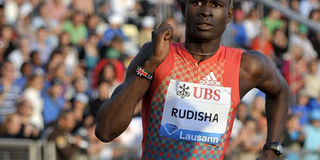Sport to score big with double increase in revenue to Sh12bn

World 800m record holder David Rudisha during a past competition. Rudisha who is currently sponsored by Adidas, among others, has been listed as the 41st most marketable athlete in the world by SportsPro magazine. PHOTO/FILE
What you need to know:
- For instance, 800m Olympic gold medallist David Rudisha, who is currently sponsored by Adidas, among others, has been listed as the 41st most marketable athlete in the world by SportsPro magazine.
The sporting industry is expected to grow and generate more than double the revenue it is currently contributing to the economy.
A report by research and audit firm PricewaterhouseCoopers (PwC) says the sporting sector will increase its earnings twofold to Sh12 billion by 2017 from the current Sh6.5 billion.
The report, dubbed Kenyan Entertainment and Media Outlook, which has been extracted from the South African Entertainment and Media Outlook, covers the period 2013-2017.
Demographic changes, urbanisation, innovation, and an expanding middle class will contribute significantly to this growth.
“The growth will come as a result of improving economic conditions and subsequent increase in mobile and household broadband penetration. Recent increases in sponsorship and media rights reflect positive developments in the Kenyan sports market,” says PwC.
According to Vicki Myburgh, the leader of entertainment and media, PwC Southern Africa, changing patterns in spending will shape industry trends at the macro and individual-segment levels, which will help achieve the growth.
“Consumers, advertisers, content creators, and digital distributors are responding to these trends. This is definitely going to increase the growth of the sporting sector,” she said.
The upward trajectory of sports in Kenya will be achieved from gate revenues, media rights, sponsorships, merchandising, and sports betting.
Gate revenues are expected to grow as a result of a steady increase in GDP as Kenyans spend more of their disposable income on the increasingly popular sporting events.
These revenues constitute 34 per cent of the total Kenyan sports market. The revenue is expected to grow to over Sh3.6 billion in 2017.
“It is also thought that the growth of rugby sevens could result in heightened interest in the sport as it is shorter and faster than the full format game and is considered to be more commercially sustainable,” notes the report.
The media rights industry in Kenya is also set to increase steadily over the forecast period, growing at 24 per cent annually and generating revenues of over Sh2.8 billion by 2017.
On sponsorship, Kenyan sport is developing, with football in particular benefiting from an increase in televised coverage and professional management of teams.
The Kenyan Premier League, for example, recently changed its name to Tusker Premier League in a three-year sponsorship deal worth Sh170 million.
The league then went on to sign a three-and-a-half-year deal with sportswear manufacturer, Puma, worth Sh10 million, showing that the Tusker deal had boosted the league’s ability to attract corporate sponsors.
In golf, Kenya Airways was named as the official airline of the Barclays Kenya Open in 2011 in a deal thought to be worth around Sh2.2 million. The competition was boosted further by an improved sponsorship arrangement with Coca-Cola’s Dasani water brand.
Athletics, Kenya’s most successful sport, received a boost when the National Bank of Kenya increased its sponsorship to Athletics Kenya from Sh20 million to Sh30 million in 2012.
For instance, 800m Olympic gold medallist David Rudisha, who is currently sponsored by Adidas, among others, has been listed as the 41st most marketable athlete in the world by SportsPro magazine.
On merchandising, Kenya is set to grow at 8.8 per cent annually over the next five years, although the previous modest growth means that revenues of Sh300 million in 2012 were relatively low.
“Merchandising sales, like gate revenues, are linked to the state of the overall economy. Growth in Kenya’s GDP will result in an increase in merchandising revenues,” notes PwC.
Merchandising revenues are also linked to large-scale sporting events. Kenya, as the rest of Africa, saw an increase in merchandising revenues as a result of the 2010 FIFA World Cup, despite the Kenyan national team not competing in the tournament. This figure fell sharply in 2011 as the influence of the FIFA World Cup declined, but grew again in 2012, thanks to the London Olympics.
In sports betting, Kenya is set to generate revenues of Sh1.4 billion in 2017, up from Sh850 million in 2012, equivalent to an 8.1 per cent annual growth rate.
However, revenues from betting will form only a small part of overall sporting revenues in the country despite having close to 90 live matches a season.




